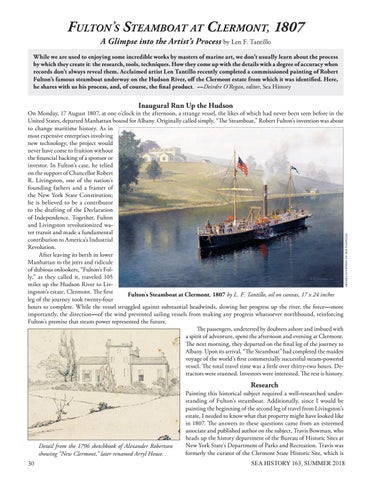Fulton’s Steamboat at Clermont, 1807 A Glimpse into the Artist’s Process by Len F. Tantillo
While we are used to enjoying some incredible works by masters of marine art, we don’t usually learn about the process by which they create it: the research, tools, techniques. How they come up with the details with a degree of accuracy when records don’t always reveal them. Acclaimed artist Len Tantillo recently completed a commissioned painting of Robert Fulton’s famous steamboat underway on the Hudson River, off the Clermont estate from which it was identified. Here, he shares with us his process, and, of course, the final product. —Deirdre O’Regan, editor, Sea History
images courtesy of len tantillo
Inaugural Run Up the Hudson
On Monday, 17 August 1807, at one o’clock in the afternoon, a strange vessel, the likes of which had never been seen before in the United States, departed Manhattan bound for Albany. Originally called simply, “The Steamboat,” Robert Fulton’s invention was about to change maritime history. As in most expensive enterprises involving new technology, the project would never have come to fruition without the financial backing of a sponsor or investor. In Fulton’s case, he relied on the support of Chancellor Robert R. Livingston, one of the nation’s founding fathers and a framer of the New York State Constitution; he is believed to be a contributor to the drafting of the Declaration of Independence. Together, Fulton and Livingston revolutionized water transit and made a fundamental contribution to America’s Industrial Revolution. After leaving its berth in lower Manhattan to the jeers and ridicule of dubious onlookers, “Fulton’s Folly,” as they called it, traveled 105 miles up the Hudson River to Livingston’s estate, Clermont. The first Fulton’s Steamboat at Clermont, 1807 by L. F. Tantillo, oil on canvas, 17 x 24 inches leg of the journey took twenty-four hours to complete. While the vessel struggled against substantial headwinds, slowing her progress up the river, the force—more importantly, the direction—of the wind prevented sailing vessels from making any progress whatsoever northbound, reinforcing Fulton’s premise that steam power represented the future. The passengers, undeterred by doubters ashore and imbued with a spirit of adventure, spent the afternoon and evening at Clermont. The next morning, they departed on the final leg of the journey to Albany. Upon its arrival, “The Steamboat” had completed the maiden voyage of the world’s first commercially successful steam-powered vessel. The total travel time was a little over thirty-two hours. Detractors were stunned. Investors were interested. The rest is history.
Research
Detail from the 1796 sketchbook of Alexander Robertson showing “New Clermont,” later renamed Arryl House. 30
Painting this historical subject required a well-researched understanding of Fulton’s steamboat. Additionally, since I would be painting the beginning of the second leg of travel from Livingston’s estate, I needed to know what that property might have looked like in 1807. The answers to these questions came from an esteemed associate and published author on the subject, Travis Bowman, who heads up the history department of the Bureau of Historic Sites at New York State’s Department of Parks and Recreation. Travis was formerly the curator of the Clermont State Historic Site, which is SEA HISTORY 163, SUMMER 2018
